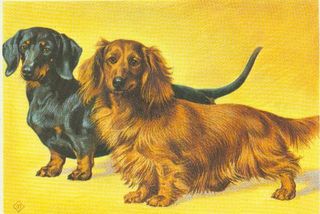
WORLD OF DACHSHUNDS!
The Dachshund Friendship Club is a non-competitive club. Our purpose is to introduce dogs and their guardians to each other and to encourage a friendly interaction between us all.
THE 34TH DACHSHUND FRIENDSHIP CLUB'S ANNUAL SPRING FIESTA WILL BE BE HELD SATURDAY APRIL 30th, 2022 AT TWELVE NOON IN WASHINGTON SQUARE PARK. WE MEET BETWEEN THE ARCH AND THE FOUNTAIN. THE EVENT IS FREE AND OPEN TO ALL.
THE DACHSHUND OCTOBERFEST IS ALWAYS HELD ON THE FIRST SATURDAY IN OCTOBER.
THE SPRING FIESTA IS ALWAYS HELD ON THE LAST SATURDAY OF APRIL.
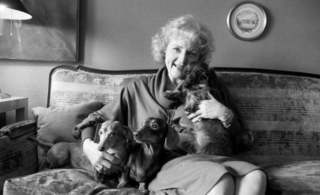
ALL THE MORE REASON TO LOVE BETTY WHITE
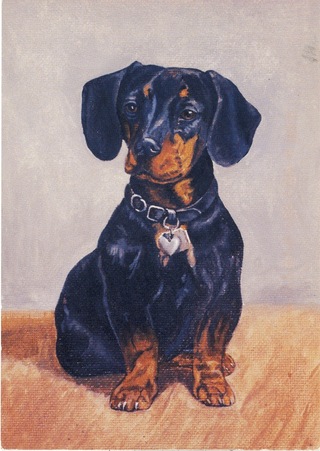
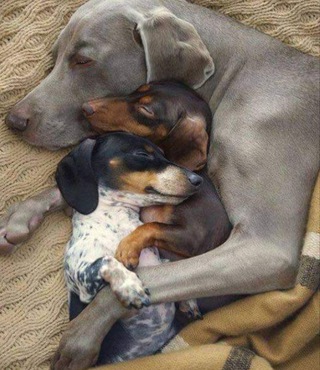

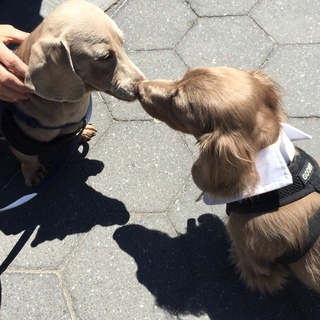
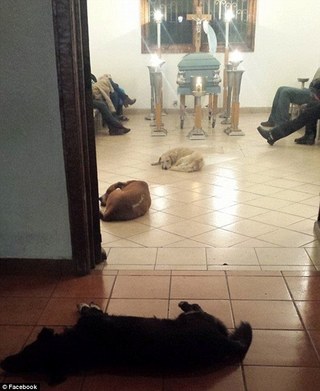

By DAVID MCCORMACK FOR DAILYMAIL.COM
PUBLISHED: 19:38 EST, 29 March 2015 | UPDATED: 07:35 EST, 30 March 2015
A funeral for a woman in Mexico took an unexpected turn when a number of stray dogs unexpectedly showed up to pay their respects.
Animal lover Margarita Suarez of Merida, Yucatan, passed away earlier this month after battling illness.
During her life she was known for her kindness to all kinds of animals and every morning she would feed the stray dogs and cats that would show up at her home.She was also known for taking a bag of food along when she went out so she could treat other strays she encountered, reports Misiones Online.
The amazing moment stray dogs showed up at a funeral to pay respects to the kindly lady who used to feed them
• Margarita Suarez of Merida, Yucatan, was well known for feeding the stray dogs and cats that would show up at her home
• Family members were stunned when the dogs suddenly appeared at the funeral parlor where Margarita's body was being kept
• On the day of the funeral, March 15, the dogs even formed a procession behind her hearse
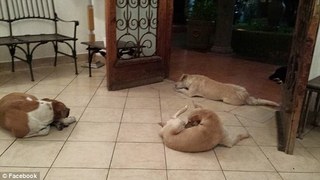
PAUL DE VRIES PASSES At eighty-three.IT IS WITH GREAT REGRET WE REPORT THE PASSING OF PAUL DE VRIES. PAUL WAS CO-AUTHOR ALONG WITH MURRAY WEINSTOCK, OF "THE DACHSONG", WHICH IS SUNG AT EVERY DACHSHUND FESTIVAL IN WASHINGTON SQUARE PARK. ONE OF THE HIGHLIGHT AT THE FESTIVAL WAS WHEN PAUL BROUGHT HIS CALLIOPE AND PLAYED WONDERFUL MELODIES FOR EVERYONE TO ENJOY.
PAUL WILL BE SORELY MISSED.
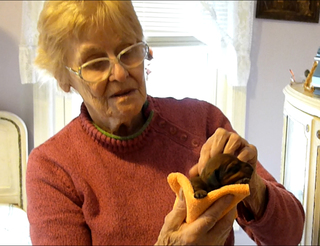
TRIBUTE TO ROBIN GIANOPOLUS
Barbara Anne Kirshner of Miller Place, New York sent this lovely tribute to longtime Dachshund Friendship Club, member Robin Gianopoulos. Robin was a well known breeder and familiar to all who frequented Westminster, the Knickerbocker Dachshund Club annual event, and The Washington Square Dachshund Festivals.
Barbara Anne writes: Robin was a loyal supporter of the Dachshund Friendship Club. In fact, she invited me to my first dachshund meeting event at the Washington Square Park. Being a dachshund lover, I was in my element surrounded by all those adorable doxies. Robin was an extremely accomplished dachshund breeder and her doxies have appeared at numerous dog shows. Her long-hair standard male, Brownie, is number one in the country presently and will appear at Westminster this year. Robin passed away on December 11, 2014 after a long and valiant battle with cancer.
Robin brought immeasurable joy into my life in the name of Melissa Tulip, my mini smooth red girl, at a time when I was devastated over the loss of my beloved dachshund, Madison.
Thank you.
Sincerely,
Barbara Anne Kirshner
Miller Place, New York
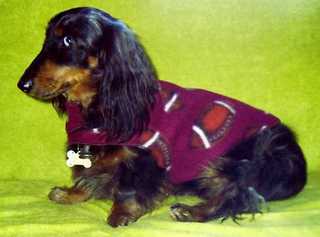
Dear Adrian-Once again I have to thank you for putting us together with Alfie Blue Eyes. It was 2003 in April. and you called me up to tell me about a longhaired tweeny boy that you had met at Stuyvesant Park in Manhattan. After you described him, I rushed down to the city to see him. I was with my father and we went in to the apt Alfie was living in, I think on 17th St. I asked the lady (Smeralda was her name) if I could bring him upstate to see how we all got along and she said OK .She explained Francis Albert (his former name) was her mothers dog. Her mother died and now Alfie was being passed back and forth from Smeralda to her brother, and they thought he should have a great home in the country. Actually by the time we left I told Smeralda that I wanted the little dog-she said fine and off we went to the Catskills Alfie was 8 yrs old, and he had been a companion to 2 older women who both had died. When they found Smeraldas mother-she had been dead for a few days. The poor little guy was stretched across the woman devastated!!!
So that's how the whole thing started. The breeding is there even if a dog has lived 8 yrs at the end of a leash. The woods with its chipmunks-squirrel, foxes turkey, deer and BEAR Alfie went to work with me and we always took him wherever went-he always fit in.
So that's the way we lived until May 2014 when I thought he might have tooth problems and possibly pain when we were in Fla. The dental had to be done, but between all the shots he probably shouldn't have had etc he developed dementia -with seizures. On Oct 14 when his FUN life didn't look like so much fun for him we made the painful decision. We got Alfie in 2003 he was 8- and in 2014-19 yrs. Not a bad life all in all!!!!!
Sincerely Suzy Cohen-Hummingbird Designs

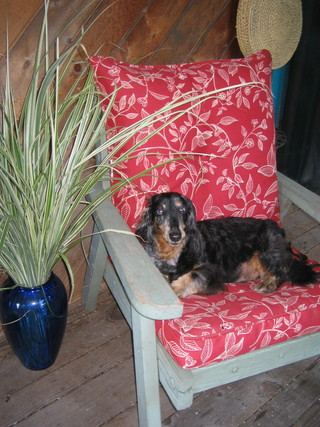

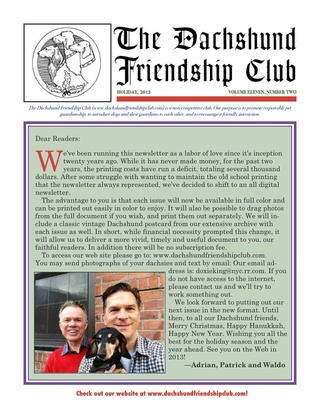
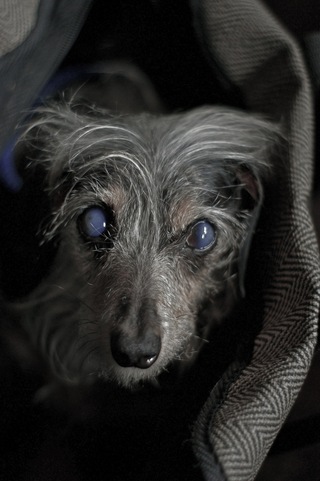
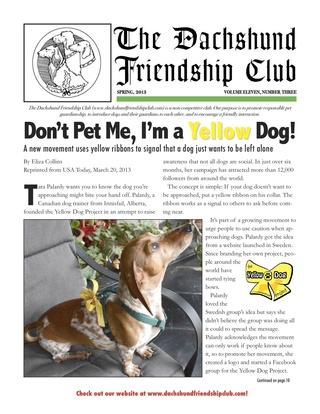
Dachshunds and the celebrities that Love them!
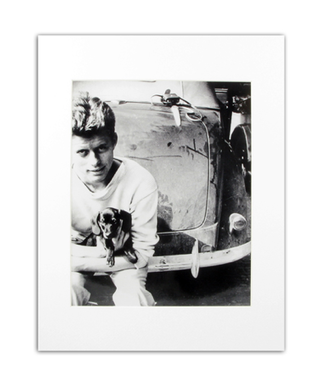
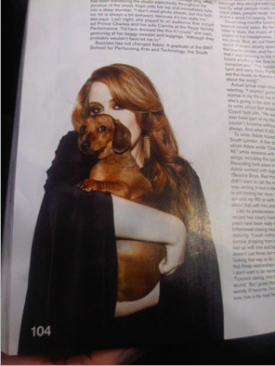
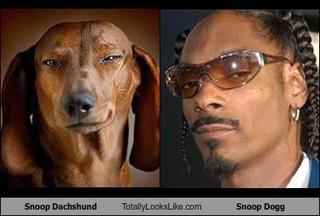


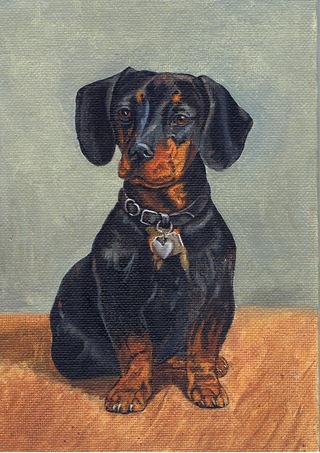


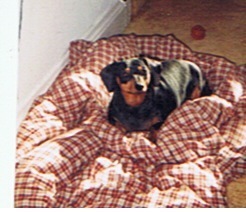
Dramatic Doxie Rescue
Brooke Collins, 22, of Juneau, Alaska went ballistic when she found a black bear attacking her dachshund, Fudge. The bear was protecting her cub from Fudge, who had barked furiously at both mother and daughter.
“The bear had Fudge in a grip, holding her in the position that bears adopt when about to eat salmon. I was freaking out. I was screaming at it and my dachsie was howling. I ran up to the bear and punched her in the snout. She immediately let go of Fudge.”
Brooke, a hairdresser, has lived all of her life in the Great Snowy White North. She says that she knows the precautions have to take against bears in their yards. But that night, Fudge, darted out of the door before she checked to see that it was safe.
Bear sightings are not uncommon but experts say they are on the rise.
“This year is a lot worse than last year,” says biologist Neil Barten of the Alaska Department of Fish and Game. He attributes that to a lack of a good berry crop, which removed one of the animals key food sources.
Brooke said that she was hoping that Fudge would calm down, however there is no sign of it yet. Fudge, who originally had a chocolate coat has now turned completely gray and has reached the age of sixteen. Her last encounter with a bear was two years before when a bear got into the finished the Collins’ basement. Animal Control came and got the bear out of the house but Fudge wanted to charge the bear and would have if she were not on a leash.
Dear Adrian:
I want to thank everyone who works on the newsletter. The graphics are so wonderful and all the letters and stories are heartwarming.
Years ago I was in a car with my sister who was driving. Suddenly I saw a little red dachshund dash out into the street from behind a large hedge. I told my sister to stop the car and I jumped out and chased the dachsie. She ran every which way. I think she thought we were playing a game. Finally I was catching up with her as she swerved behind the hedge where I first saw her darting out of. As I turned the corner I bumped into a rather large fellow and was practically knocked unconscious.
My sister got out of the car and raced towards me as I lay supine on the lawn. The dachshund had stopped and came and stood over me, staring at me with the sweetest eyes I have ever seen. The fellow who I bumped into was most apologetic and helped me up and set me on a garden bench. At that moment his mother came out with a pitcher of water and poured a tall glass of water for me. I was introduced to mother and son. She was Molly and he was Ben. The little dachsie was Ida.
My sister took me home and a few days later there was a knock on our screen door. Outside the door I saw Ben with Ida in his arms. He said he came to thank me for my efforts at catching Ida. I invited him to sit on the porch and my sister, Mary, brought out some lemonade. Too make a long story short Ben and I began dating and were married two years later. That was twenty years ago, and of course we have always had a dachshund as part of our family. Today our special friend is Wally, who never stops amusing us and giving us lots of love.
Hello to all Doxie lovers, Jane-Anne Waters, Winston-Salem, North Carolina
HEROIC AND COURAGEOUS DACHSHUNDS
A tiny dachshund in Yamhill, Ore., named Missy is being hailed as a hero for saving her owner's life.Charlie Burdon was recovering from open heart surgery when he had a vertigo attack. The 66-year-old was so ill he couldn't even move.
Missy, sensing something was wrong, scurried to neighbor Charles Mitchell's home to get help. Mitchell said the 11-year-old dog started barking relentlessly and wouldn't leave until he started to follow her home.
"I said, 'Missy - Charlie don't know you're here -- you better go back home,' Mitchell recalled. "She just stood there and looked at me."
When he discovered his neighbor's condition, he called the paramedics to the house and Burdon's life was saved.
"Not in a hundred years would I think she would save my life like this," Missy's owner said. "She just did it on instinct. It's just - remarkable."
DACHSHUNDS WILL NOT STAND DOWN
This is the tale of two mini's that live in the a rural area that is mostly high desert. Rattlesnake's are common and very unwelcome! When a woman heard a scrap going on out side, she went out to see what all the fuss was about, only to find her two doxsies doing full battle with a Mojave green rattlesnake! She tried to get the dogs to back off, but they wouldn't. She watched her male take a direct hit on the nose, didn't phase him, he kept attacking, then the female took a hit on the shoulder, she didn't back off either.
They didn't stop until they killed the rattler! Amazing courage! The woman took both dogs to the closest vet, and she was smart enough to bring the dead snake so it could be identified. Indeed it was a Mojave Green, the deadliest of all the rattlers around here. The vet did not have enough anti venom on hand and had to locate four vials. The female took a dry hit and was sent home. The male named Dutch needed all 4 vials of ant venom and was in critical conditions for 4 days. On the 5th he started to show improvement and on the 6th day sent home. He will be fine except for some eye damage caused by the bite. The total vet bill came to $10000(Yes 10 thousand!) The woman was retired and now plans to return to work so she can pay vet bill.

The 411 for Your Jet-Set Pet
You think you've got it bad: braving airport traffic and waiting in mile-long security lines, all for the privilege of resting your chin on your knees for a five-hour flight in an economy-class seat. So imagine how air travel feels for your cat or dog, who has no idea what's going on as he's packed into a crate, loaded into a cargo hold, subjected to very strange (and very loud) noises and -- worst of all -- separated from you. The reality? You probably can't make this a fun experience for him. You can, however, make things go a lot more smoothly by following these tips.
1 Get informed
When reserving plane tickets on the Web, check the airline's pet travel policy, which can usually be found under a category like "special services." If you're reserving by phone, ask the agent to fill you in -- not only on rules and regulations, but also on how animals are transported. One question you'll want answered before booking: Will my pet be subjected to any extremes in temperature? Although the Animal Welfare Act prohibits animals from being held in temperatures below 45 degrees or above 85 degrees for more than 45 minutes during transport, it may not take anywhere near that long to make your pet uncomfortable. "If you're traveling in the summer, make sure to book an early-morning or late-evening flight," advises Jim Rogers, a spokesman for the Agriculture Department's Animal and Plant Health Inspection Service. "In winter, schedule your flight for the afternoon." Find out whether your pet should be taken to the regular baggage check-in or the cargo desk, as well as how many hours before departure you'll need to check him in, what papers to present and what fees are involved. (They typically run $75 to $100 per pet, one-way.)
2 Get a checkup
Dogs and cats must be at least eight weeks old and fully weaned to travel on planes. Most airlines require that a certificate of health, issued by a licensed veterinarian no more than 10 days before the date of travel, accompany your animal onboard. "We basically give them a physical to determine whether they can handle the stress of flying," says Lynn Logan, a staff veterinarian at Friendship Hospital for Animals in Washington. "We need to make sure that they're not too underweight or geriatric, and also that they're not carrying any infectious diseases." Certain breeds of pug-nosed dogs (such as boxers and bulldogs) are more likely to experience respiratory problems on planes and generally shouldn't fly.
3 Get equipped
Believe it or not, if your pet can fit in a small crate beneath the seat in front of you, many airlines will allow you to store him there (though there's a limit on the total number of pets that can travel in the cabin during a flight; it's usually two or three in coach, first come, first served). Animals who need to be stored in cargo require a travel kennel, which can be procured from any major pet store and must meet certain size, strength and sanitation specifications. Food and water dishes must be securely attached to the structure (travel kennels often come with these already); attach instructions for feeding and giving water in case of emergency. "Bring the leash with you, so you can take your pet outside the airport right before you board and right after you land," Rogers says. Finally, your pet should have a collar with an ID tag bearing your name and phone number. For details, visit the Agriculture Department's Web site on traveling with pets at www.aphis.usda.gov/oa/pubs/petravel.html.
4 Get permission
If you're traveling with your pet internationally, know that many foreign countries and U.S. territories (as well as Hawaii) have quarantine or health requirements for animals entering the country. Contact the embassy or consulate of your destination country at least four weeks before travel to determine its policies (www.embassy.org/embassies is a good place to start). For information on Hawaii's rules, contact the state's Agriculture Department(808-483-7151, www.hawaiiag.org/hdoa).
5 Get assistance
No time to deal? Hire a professional pet transport service to handle the details for you, including booking your pet's ticket, taking him to the airport, checking him in and bringing him to you upon arrival. (You'll still need to buy the right kennel and get him certified to fly.) Three such services are Happy Tails Travel (800-323-1718, www.happytailstravel.com), Pet Transporter Worldwide (800-264-1287, www.pettransporter.com) and Pet Express (866-738-6683, www.petmove.com).
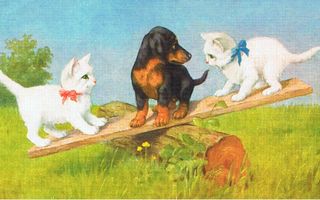
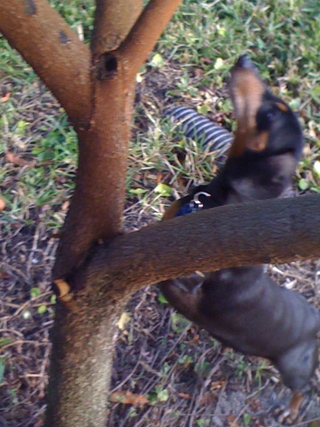
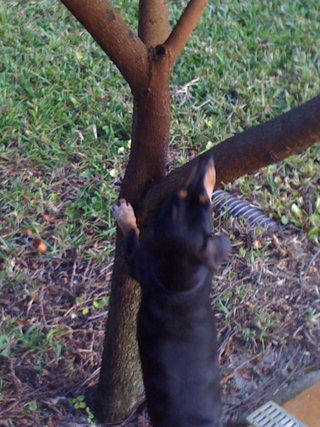
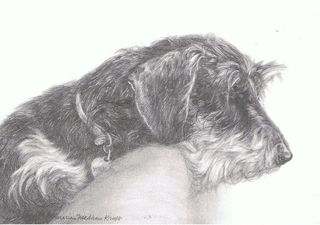
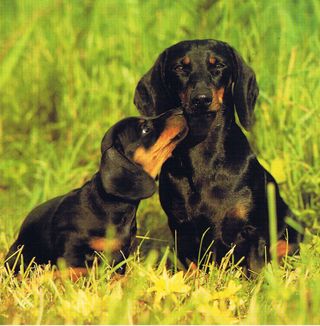

Hi Adrian:
My daughter Katie was visiting and she brought her mini dachshund, Reaghen, with her. Reaghen is on the right, taking over Lexi’s blanket. Lexi is not happy-but then they fall to sleep together and both took a nap on the blanket.
All the best, Mary Carhart, Portchester, New York

Dear Adrian:
I have been extremely neglectful in sending you a remittance for the newsletter which I so appreciate. You will be receiving a check from Wells Fargo which hopefully will cover a continuing subscription with some extra for your work with dachshund rescue. Golda and Sophie are doing well, although Sophie is shy and barks at anyone who comes into the house and Golda just wants to love them. The new boyfriend gets exasperated with Sophie because she gives him so much attitude. But
she is getting used to him and calms down eventually. I wonder if I have a new picture? I have two that show them being still. One is with their friend Ruby. It shows the spot on Sophie’s side which was there when I got her from the breeder. I asked what it was from, as she took a long drag off her cigarette she said "I don't know. That just happens sometimes". Maybe that is why Sophie is so skittish. The other is one example of how they take over my bed. I see I don't take near enough pictures for a true doxie lover.
Thank you, David Hallaby, Las Vegas, Nevada
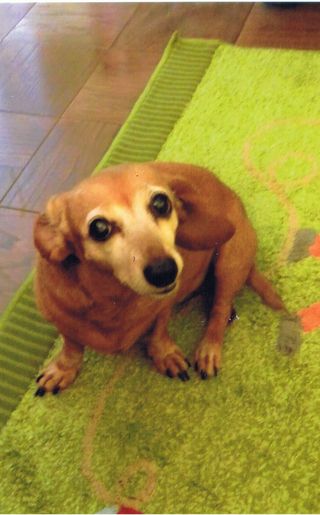
hereDear Adrian and Liz: (photo of MICKEY)
Congratulations to the great idea, The Dachshund Friendship Club, on its twentieth anniversary. Thanks for the hard work and fun for the doxies and their families. We joined the club when we adopted Mickey eight years ago and we love the doxie festivals in the park and the newsletter.
The photo shows, Mickey, who is now twelve. We adopted her when she was four. As you know, every doggie is special to its family, but Mickey is even more special to us for the story I am about to tell.
Roughly a year into joining our family, Mickey started barking frantically around two in the morning, which woke us all up. As Mickey grew increasingly agitated and would not stop barking my wife asked me to get up and go see what the cause for the ruckus was. As I opened the bedroom door Mickey dashed out into the living room and started jumping at the side of the air conditioner signaling to me a flame that was coming out from inside the unit and was being fanned by the airflow surrounding it.
Thanks to Mickey’s early warning, I was able to douse the flames while it was contained in the air conditioner unit, and before it spread throughout the living room. Importantly, because of our home’s configuration, the flames would have most likely spread throughout the entire apartment, where we would have been trapped in our bedroom with no way out, by the time we realized what was going on.
Since joining our family eight years ago, Mickey has been giving us the gift of her love and her antics, but she also gave us her smarts and her heroism that saved us from great harm. We fell in love with Mickey since the first time we saw her, and there are no words to express how thankful we are to her for this deed.
All the best, J.G. Sas, New York City, New York
Dear Adrian:
I sit here on Thanksgiving morning reading the Fall 2010 newsletter thinking how grateful I am for my doxies past and present and for the gift of the Dachshund Friendship Club.
In two thousand and eight we lost our beloved Flower. Though we still grieve today, we are thankful for the grace of her life and the time we had with her. We are also thankful for our precious boy, Danny, a four year old rescue who has been with us for a year and rules the house and our hearts. He is the ultimate ham and add so much to our lives. I wish you and yours a happy and healthy Holiday season.
Best wishes, Adriana Fargelli and Julie Pollitz, Riverdale, New York
The writer E. B. White once wrote:" Being the owner of dachshunds, to me a book on dog discipline becomes a volume of inspired humor. Every sentence is a riot. Some day, if I ever get a chance, I shall write a book, or warning, on the character and temperament of the dachshund and why he can't be trained and shouldn't be. I would rather train a striped zebra to balance an Indian club than induce a dachshund to heed my slightest command. When I address Fred I never have to raise either my voice or my hopes. He even disobeys me when I instruct him in something he wants to do."

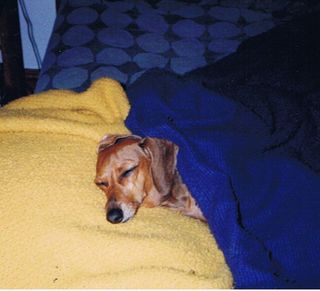
DACHSIES SURVIVE DISASTER
After Katrina hit in 2005, the dachshund pups were found wandering the streets of New Orleans.
Paul Fowler, and artist from the Big Easy took them in and made a vow: “I promised them I would never abandon them.
So when Tulane University sent Fowler’s wife, Christine, to Haiti three years ago to help combat the spread of AIDS, Bella and Dieter came a long. Then the earthquake struck in Haiti.
Fowler, 41, was outside by the pool with his daughter, seven month old, Victoria, when he ground opened up. Raging like a monster and lifting them four feet in the air.
“ I was sure we were going to die, “ Fowler said. “It sounded like hell was opening up. I told my baby goodbye.”
When the ground finally stopped shaking, Fowler and his baby were still alive and somehow the Montana Apartments, down the block from the Hotel Montana remained standing.
Fowler dashed upstairs to find to find his third-floor apartment destroyed. He called to the dogs. Silence. Thinking them dead he went for the door, when a bark made him stop. There they were, under the bed, terrified and confused.
“I don’t know how they made it,” he said.
It took three days for the family to walk to the U.S. Embassy in Port-au-Prince. Once there, Fowler was told a C-17 transport plane would evacuate his family-but the dogs had to stay.
Desperate, Fowler left them with a friend who family runs the orphanage God’s Littlest Angel.
“I left them behind thinking I would never see them again,“ Fowler said. “I can still see their faces in total confusion as I left. It broke our hearts.”
The Fowlers have been staying in West Palm Beach with relatives since arriving in the States. It was Fowler’s sister’s idea to contact the Humane Society of the United States.
“I never expected anyone to champion the dogs,” he said. “I am overwhelmed by their efforts. They went out of their way to help us and the dogs.
Fowler lost everything he owned in the quake, but he feels like the luckiest man alive. A few days later the family went to the Miami airport to pick up Dieter and Bella. After being bumped from their morning flight the dachsies flew in Friday to Miami International Airport for a tail-thumping reunion. Paul Fowler lowered himself to the floor and Bella and Dieter climbed right up and gave him a multitude of kisses.
The next step in the family’s journey is to head back home to New Orleans and begin their lifes all over again.

There will be a Dachshund Winterfest on the last Saturday in January in Miami Beach, in the South Beach area on the ocean at 11th and Loomis Park.
In New York our next gathering is the Dachshund Spring Fiesta which will be held on the last Saturday in April in Washington Square Park at Twelve Noon. We meet between the fountain and the arch.
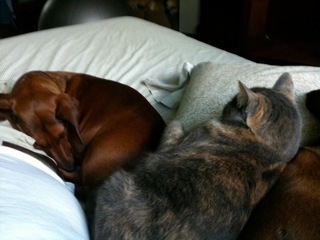

Jimmy is a wonderful dachshund who will turn 3 in June. He is very social and
get’s along well with people, dogs and cats, and is exuberant at play. He loves all
toys and likes to snuggle, burrow and cuddle. Jimmy is very smart, knows many
commands, and is trained to use wee wee pads, though he is not as consistent
in other people’s homes. Jimmy is a joyful survivor who needs a loving owner
who is careful but not too fussy, since he does have a number of medical issues.
In December 2008 he had encephalitis, from which he has fully recovered and
is in excellent health. Unfortunately, he was left with damage to his right eye
(which needs to be treated twice a day with eye wash and anti-inflammatory
medication) and his tongue is partially paralyzed. As a result he needs a deep
water bowl and should be fed small pieces of food. Jimmy does well outdoors
in all but the hottest weather.
Please contact Lisa at 917-447-6889 or hazen.lisa@gmail.com
To our knowledge all images on this site are not in copyright. If you see an image on this site that has a copyright please let us know and we will remove it. Thank you.


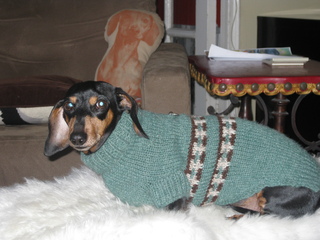
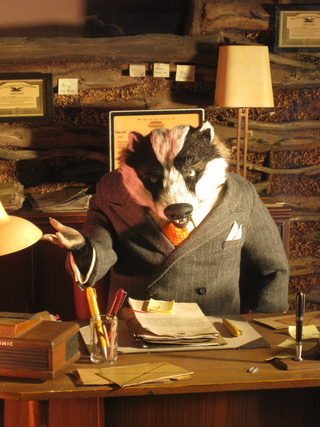
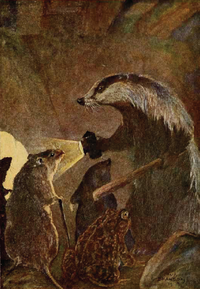
BADGERS
Badgers, occasionally referred to as brocks, are short-legged, heavy-set carnivores in the weasel family, Mustelidae.
The dachshund dog breed has a history with badgers; "dachs" is the German word for badger, and dachshunds were originally bred to be badger hounds.[10]
Their lower jaw is articulated to the upper by means of a transverse condyle firmly locked into a long cavity of the cranium, so that dislocation of the jaw is all but impossible. This enables the badger to maintain its hold with the utmost tenacity, but limits its jaw movement to hingeing open and shut, or sliding from side to side without the twisting movement possible for the jaws of most mammals.
•
The word badger originally applied to the European Badger (Meles meles). Its derivation is uncertain. It possibly comes from the French word blaireau: "corn-hoarder", or from the French word bêcheur (digger), introduced during William the Conqueror's reign.[1] The Oxford English Dictionary, however, states that the most likely derivation is from badge + -ard, referring to the white mark borne like a badge on its forehead.[2]
The less common name brock (Old English: brocc), (Scots: brock) is a Celtic loanword (cf. Gaelic broc and Welsh broch, from Proto-Celtic *brokko) meaning grey.[2] The Proto-Germanic term was *þahsu- (cf. German Dachs, Dutch das, Norwegian svin-toks; Early Modern English: dasse), probably from the PIE root *tek'- "to construct," so that the badger would have been named after its digging of setts (tunnels).
A male badger is a boar, a female a sow and a young badger is a cub. A collective name suggested for a group of badgers is a cete,[3] but badger colonies are more often called clans. Badger dens are called setts.
The behavior of badgers differs by family, but all shelter underground, living in burrows called setts which may be very extensive. Some are solitary, moving from home to home, while others are known to form clans. Clan size is variable from 2 to 15. Badgers can be fierce animals and will protect themselves and their young at all costs. Badgers are capable of fighting off much larger animals such as wolves, coyotes and bears. Badgers can run or gallop at up to 25–30 kilometres per hour (16–19 mph) for short periods of time.
North American Badgers (Taxidea taxus) and Coyotes (Canis latrans) have been seen hunting together, in a cooperative fashion.[5]
American Badgers are fossorial carnivores. Unlike many carnivores that stalk their prey in open country, badgers catch most of their food by digging. They can tunnel after ground-dwelling rodents with amazing speed. They have been known to cache food.
In North America, coyotes sometimes eat badgers and vice versa, but the majority of their interactions seem to be mutual or neutral.[8]
Badgers have been known to become intoxicated with alcohol after eating rotting fruit.[9]
Eurasian badger.
For more details on badgers and bovine tuberculosis, see Eurasian badger.
Hunting badgers is common in many countries. Manipulating the badger population is prohibited in many European countries as badgers are listed in the Berne Convention, but they are not otherwise the subject of any international treaty or legislation.
The blood sport of badger-baiting was outlawed in the United Kingdom by the Cruelty to Animals Act 1835 as well as the Protection of Badgers Act 1992 which makes it a serious offence to kill, injure or take a badger, or to damage or interfere with a sett unless a licence is obtained from a statutory authority. An exemption that allowed fox hunters to loosely block setts to prevent chased foxes escaping into them was brought to an end with the passage of the Hunting Act 2004.
Many badgers in Europe were gassed[citation needed] during the 1960s and 1970s to control rabies. Until the 1980s, gassing was also practised in the UK to control the spread of bovine TB.
A Scandinavian custom is to put eggshells or styrofoam in one's boots when walking through badger territory, as badgers are believed to bite down until they can hear a crunch.[citation needed] The dachshund dog breed has a history with badgers; "dachs" is the German word for badger, and dachshunds were originally bred to be badger hounds.[10]
FOOD
Although rarely eaten today in the United States or the United Kingdom,[11] badger was once one of the main meat sources in the diets of Native Americans and white colonists.[12][13][14][15][16] Badgers were also eaten in Britain during World War II and the 1950s.[13]
In Russia, the consumption of badger meat is still widespread.[17] Badger, along with dog and pork, shish kebabs are cited as a major source of trichinellosis outbreaks in the Altai region of Russia.[17] Consumption of badger meat also occurs in other European countries such as Croatia, where it is used in a variation of the traditional dish of goulash.[18] In contrast to Russia, there are no reports of trichinellosis related to the consumption of badger meat. This is credited to adequate preparation of the meat and good thermal processing of it.[16]
In France, badger meat is used in the preparation of several dishes, such as Blarieur au sang and it is a relatively common ingredient in countryside cuisine.[19] Badger meat was eaten in some parts of Spain until recently as well.[20]
Badger remains a source of food in China, and the meat is freely available in market places.[21][22] Other Asian countries also have traditions of consuming badger meat. In Japan, it is mentioned in folktales where it is regarded as a food for the humble.[23]
Commercial use
Today badgers are commercially raised for their hair, which is harvested to make shaving brushes. Because badgers are a protected species in North America and most of Europe, virtually all commercial badger hair comes from mainland China, which supplies knots of hair in three grades to brush makers in both China and Europe. In rural Northern China, badgers multiply to the point of becoming a crop nuisance, and village cooperatives are licensed by the national government to hunt badgers and process their hair.[24] The hair is also used for paint brushes, and was used as a trim on Native American garments.[25] It has been used in some instances as doll hair.[citation needed]
In Popular Culture
Badger, Rat, Mole, and Toad from The Wind in the Willows.
• The 19th century poem "The Badger" by John Clare describes a badger hunt and badger-baiting, it treats the badger as a noble creature which dies at the end.
• Badgers are popular in English fiction. Many badger characters are featured in author Brian Jacques' Redwall series, most often falling under the title of Badger Lord or Badger Mother, and most are powerful warriors. Other stories featuring badgers as characters include:
o Beatrix Potter – The Tale of Mr. Tod (Tommy Brock)
o C. S. Lewis – Prince Caspian (Trufflehunter)
o Kenneth Grahame – The Wind in the Willows
o T. H. White – The Once and Future King and The Book of Merlyn
o Roald Dahl – Fantastic Mr. Fox
o Colin Dann – The Animals of Farthing Wood
o Erin Hunter – Warriors
• The character Frances in Russell Hoban's series of children's books is a badger. Badgers also appear prominently in two volumes of Erin Hunter's Warriors: The New Prophecy series, and a badger god is featured as a major character and spirit guide for the lead character in The Immortals series by Tamora Pierce. The scene is set for Tom Holt's Expecting Someone Taller during an encounter with a badger, which is the final manifestation of a Germanic mythological character.
• Badgers have also been used to symbolize organizations in fiction such as the Badger Army in Orson Scott Card's novel Ender's Game or house Hufflepuff in the Harry Potter series.
• "The Badger" is a Wisconsin-based superhero created by Mike Baron. The Badger comic book series was published by First Comics between 1986 and 1991 and lasted 70 issues; the first four issues were published by Capitol Comics, and after the conclusion of the First Comics series several mini-series were published by Image Comics in the early 1990s.
• Badgers also have been referenced numerously in works including "Weird Al" Yankovic's cult classic, "UHF" and the animated short Badger Badger Badger.
• The British children's TV show Bodger and Badger features a talking puppet named Badger, and his confidant Bodger.
• In Walt Disney's 1973 film Robin Hood, the character Friar Tuck is a badger.
Miscellany
• The badger is the state animal of the U.S. state of Wisconsin. Likenesses of badgers appear through the Wisconsin State Capitol, and a badger appears on the head of the statue of Wisconsin atop the building. The official mascot of the University of Wisconsin–Madison is Buckingham U. Badger, or Bucky Badger.
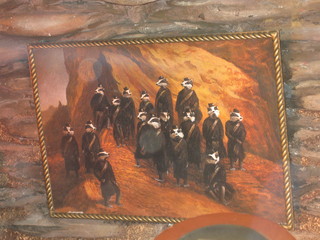
LETTERS
Dar Adrian:
Greetings from Vermont!
We're still enjoying an Indian Summer but have been stacking wood for the Fall. Lucy is getting to be a real country girl! She's a happy dog and gives us so much love and so many laughs. Hoping you are all well and have enjoyed a good summer.
Thought you would get a kick out of "The Dachshund March" in Krakow.
I read your column on pet insurance for Waldo and how it worked out for you. When we get back to Connecticut Dave and I are going to look into it. Which company did you use?
Love to All
Joan Dave Spikol, and Lucy
ED. NOTE: I use Veterinary Pet Insurance, VPI. com
Annual dachshund parade brings barking good fun
One of Krakow's weirdest traditions, the annual Dachshund March (Marsz Jamników in Polish) took place this past Fall, with dozens of the iconic short-limbed dogs and their owners participating. For the fifteenth year, dachshund lovers from all over Poland have gathered in Krakow to show off their best furry friends. While some come just for the experience, many go as far as dressing up their sausage dogs in all sorts of elaborate costumes - and some are rewarded for their efforts. This year's winner of the costume contest featured a coarse-haired pup dressed up as an Egyptian pharaoh, royally escorted by his human companions, who donned Arabic dress and even had a soundtrack for his majesty's entrance. Honorable mentions went to dachshund police officers, doctors, sports dogs, and one graying canine who had participated in every year of the march.
The annual parade, sponsored by the Gazeta Wyborcza daily and Radio Krakow, celebrates human accomplishments as well. Each year, a local artist is awarded for the best dachshund-related masterpiece, and a local writer is selected as the winner of the literary competition. This year, Witold Witkowski took the latter prize with his poetic ode to the sausage dog, while the artistic award was scooped up by Agata Stachowicz, for her dachshund earrings.
Dear Adrian:
Sorry to be late with subscription dues. I guess I have lost my good sense over my newest adopted, “Gherkin”—She came with that name which seemed just right since I live on Pickle Road. She is just perfect.
Thanks to you and Liz for all the pleasure you give us.
Best Wishes, Janet Beattie, Pottersville, New Jersey
Dear Adrian
Schatzi and Daisy Ray have become wonderful companions to each other and are a constant source of entertainment. Daisy makes up for her petite size with typical female flair, trying to be bossy and conning her buddy into playtime. Given identical toys or bones they inevitably want what the other has—typical doxies! Schatzi is more of a pacifist and will give in to her whims but if he waits long enough she will tire of the object of her desire and he gets it in the end.
Best Wishes, Linda and Gregg Karl, Levittown, New York
Dear Adrian:
We look forward to each newsletter—it helps us to know that others share our love of dachsies (and their bad habits!). Enclosed are family pictures that includes my sister’s new puppy, Wilson. What a love!
Thanks for al you do, Geri and Bob McMullin, Doylestown, Pensylvania
Dear Adrian:
This is our newest addition, Dotty. She came from that huge puppy mill in West Virginia that was broken up in August, two-thousand and eight. We went to North Shore Animal League and scooped her right up.
She is oh so timid with nearly everyone we encounter who is human. Dogs, she could no care less about. But she loves her new status as Queen Dorothea in our house. We are trying our best to make up for all of the woes she surely endured in that puppy mill. There were nearly one-thousand dogs that were removed from that horrible place.
It’s so much fun to receive the newsletter, Rachel Goldman, Larchmont, New York
Dear Adrian and all the folks of The Dachshund Friendship Club.
My dachshund, Chilli, is the light of my life. H is so cuddly and gentle yet playful and energetic. All who meet him fall in love with him. His great mix of charisma, intelligence and good looks make humans and dogs flock to him. I joke around and say he is a “local celebrity” because everyone in my neighborhood knows him. He loves to relax and has ‘lazy days’ if possible.
Thank you, Kristin Fagan, Long Beach, New York
Dear Adrian, Patrick, and Waldo:
I was be unable to attend this year’s Dachsie Octoberfest as I was married on that day. Otto, my four year old wore his tux as ring bearer and Lola, our Chihuahua, was our flower girl. We were married in Prospect Park and our other two dachshunds were there as well. We would ONLY get married somewhere where they would allow us to have dogs.
We have been so busy planning this wedding this past year that the newsletter slipped our minds. We are so excited and can’t wait for our wedding day but a small part of us was sorry to miss all the wieners that day. As we mentioned, we did not realize we were getting married on Doxie day, but once we realized it the irony wasn’t lost on us.
Thanks, Andrea and Louise Katz, and Hubby, Derrick
Dear Adrian;
Sorry for the dues delay. Please find enclosed a check for the next three years. We have been subscribers for many years and would hate to miss an issue.
Cheeto and Romeo are doing fine. Now they are nine and ten years old. They were both rescues from abusive homes but both have turned out wonderful and have me well-trained and control my life.
This photo shows them on New Year’s Eve.
Thank You, Robert and Judith Carts, Lady Lake, Florida
Dear Adrian,
As you know, I had to let my beloved C.C. go last April. I was devastated but knew I had to have another dachshund because she had brought so much love into my life. I was going to contact a breeder, knowing it could take months to get a puppy. I wrote to Sandi Schiffman to ask if I could use her as a reference in contacting the breeder through whom she got Teva. I guess fate had stepped in; Sandi had just begun fostering a pregnant miniature dachshund for Animal Haven, the shelter at which Sandi works and volunteers.
On May Twenty-fourth, the dachshund gave birth in Sandi's apartment to 6 puppies; unfortunately, one of the females lived only one day. The five that survived, 2 females and 3 males, stayed with their mother in Sandi's apartment until they were ready for adoption at 8 weeks of age. Their coloring varied a lot; there was a dapple male (the color of the father), a red dapple male, a wild boar male (the color of the mother) and 2 red females, one of which has some dappling. I got to meet the 2 females (I was only interested in a female) on July Fourth, when they were 6 weeks old. They were very tiny (less than three pounds) and afraid, not wanting to leave Sandi's lap! I chose the one I considered to be the prettier of the two - the one that looked more like C.C. Taffy is a very sweet, mischievous, beautiful girl who has helped to heal my broken heart. She is red with some dappling. Her name comes from the way the candy is made - by stretching it! She came into my life exactly 3 months after I lost C.C.; sooner than I expected to have another dog, but I couldn't pass up the opportunity to adopt exactly the dog I wanted from a shelter!
I look forward to many happy years with my new baby.
Happy holidays to you, Patrick, Waldo, and all my fellow dachsie-lovers!
Sincerely, Dorothy Schafler
Dear Adrian:
Macbeth was fourteen at the end of September and is beginning to show his age. He has some bad days and does not get out of bed or eat much. However, on his “puppy days,” he runs like a demon, eats everything in sight, and loves to play with Smokey, his four year old German Shepherd mix housemate. Mac believes that Smokey is his pet and treats him as such, even trying to tell him where he is allowed to go when they are out on a walk together.
Thank you for a very enjoyable and extremely informative newsletter. Keep up the good work!
All the best, Jennifer Schneider
Sear Adrian:
Here’s Wilson! Isn’t he beautiful and so handsome. We spoke on the phone last April and informed you we were looking for a black and tan dachshund. Our first one, Hannah the Hound, passed away in November. We did not think we could ever find another one to compare to her—but we have had such luck. Wilson is a complete love and has brought joy back into our heart.
Wilson came from Lorraine and David Simmons of Virginia. In May when I contacted Lorraine she only had two left from a litter. There were two males, one red and one black and tan. She forwarded us a photograph and I knew right away that Wilson was coming to our home.
He is now five months old. We absolutely love him and enjoy having a dachshund puppy around.
Hope everyone is doing well, Sincerely, John and Joanne Fedash, Morristown, New Jersey
Dear Adrian:
Once again I want to thank you for making Loki the little Happy Halloweener dog on the cover of the last Dachshund Friendship Club newsletter. I asked you to print something on doggy dementia and I will be happy to talk about what it is like to have an 18-year old wiener dog. First of all, it is a bittersweet time. You remember what fun your dog was for many years and this is no longer the case. Loki is a shadow of her former self. She is deaf, she has cataracts and we don't think she sees very well. She had many teeth removed a while back and we think she has lost her sense of smell. Our vet told me dogs won't eat something if they can't smell it, so now I push Loki's nose gently into her food. Once she gets a 'whiff' she will usually eat something. Our backup food for her is Gerbers or Beachnut Baby Food, chicken and turkey. It is smooth and was recommended by our vet. I also cut up food for Loki into very small pieces or else pulse it in the food processor. She still gets a little treat of Edye's slow churned vanilla ice cream at night. She does better on less fat. In fact, we were advised no Little Caesars or other gourmet dog food as it has too much fat and salt. And of course, a Trader Joe cookie broken into little pieces.
I'm going to include here an excerpt from WikiAnswers - What are the symptoms of canine dementia.
Doggie Demential a medical condition known as canine Cognitive Dysfunction Syndrome (CDS) causes disorientation, confusion, memory loss and personality changes that are very similar to Alzheimer's disease in humans. Canine Cognitive Dysfunction is sometimes referred to as old dog syndrome....
Some age-related changes, like a graying muzzle, are inevitable. Older dogs are more sensitive to temperature extremes and they move a bit slower. (FOR SURE). The main symptoms of CDS are summarized by the acronym DISH....
Disorientation - Interaction changes - Sleep changes - and House soiling.
Sometimes a disoriented dog ...
Stops responding to his/her name
Forgets once familiar tricks
May stop responding to even basic commands
No longer remembers routines
Stares blankly into space or at walls
Gets stuck in corners, under furniture or behind furniture
Engages in repetitive and compulsive disorders
Paces or wanders aimlessly
Compulsively walks in circles... around a table or from room to room
Appears lost or confused, even in familiar surroundings
Dogs who knew exactly where their yard ended and never crossed the line, wander past the normal boundaries, becoming lost or confused
Easily agitated and/or barks for no reason
No longer greet visitors or even family members
No longer try to get attention (however when she wants some of what we are eating, she will nuzzle my leg or foot under the table)
No longer care about being petted
They walk away even when being petted and receiving affection
Dogs who experience changes in sleep patterns...
Sleep more during the day
Sleep less at night
They sometimes forget house training
Have 'accidents' indoors ... even soon after being outside
Stop 'asking to go out'
They seem to forget the reason for going out.
Loki has experienced a number of these symptoms. A very hard one for me to accept is that she really does not want to sit in my lap anymore. It is a great day if she wags her tail. This does not happen often. Of course since she lost her hearing we try hand signals for COME. Sometimes works, sometimes not. She no longer can roll over on command or hand signal, as she used to do. She does not run and play. No toys for her at this point. She always was a picky eater, now I'm thrilled if she eats once in a day. A red letter day is two small meals. She used to weigh nine and a half pounds for many years, her weight never varied. Now she is down to five and a half pounds but our vet says this is probably one of the reasons she is still with us, no overweight doggie here. As our vet also said, SHE has US on a schedule.
We have three beds for her, well two beds and her crate. We always crate her if we have to go out and leave her. It is soft and comfy in the crate and we know she is safe from hurting herself. She does wander from the kitchen to the dining room to the living room and back again in a big circle. She is prone to having an accident if we don't keep her on schedule. We always carry her out because from her bed to the back yard she might decide 'oh what the heck, this seems like a good place to go to the bathroom'. Yikes to that. She sleeps about twenty-three and three quarters hours per day. And that includes most nights all night. Thank goodness for the all night sleep. She will still give kisses when I pick her up and stroke her, thank goodness for that. I'm as sure as any mom can be that she is content, she is definitely NOT in any pain, she walks slowly but she walks on her own, no problems; it is as if she is training us for when we don't have her anymore. Sometimes, we feel as if we don't have a dog. The first thing to go was her hearing and we realized, the doorbell rang and she did not hear it. No more watchdog. On the other hand, I can vacuum right around her and she barely notices it.
In consultation with our vet we decided not to give her medication. At this point, she only takes medication for an intestinal condition. No other medication. She does not come in contact with other dogs and basically stays in our fenced-in yard. She does not like to be outside that much. She usually can find her bed, but sometimes stands in front of it as if she can't remember how to get in. We still have her groomed about every 2 months. She is a long haired dachsie and looks better now in her old age with a slightly shorter haircut. It is also a good way to avoid the trauma of trying to cut her nails. We have to medicate her with a compounded liquid version of Metronidazole which my husband 'shoots' down her throat while I hold her and her head immobile. Thank goodness we only do this 3X per week.
Loki loves soup so I try to give her soup with her food. She pushes her food around and drops some due to the gaps in her teeth. I found a round plastic tray with a 'lip' and I put her food plate on that and then pick them both up to wash in the sink. Keeps the floor a lot cleaner. My husband is retired and I am semi-retired so it is not a big deal for us to plan our day and take care of our baby. My husband has said he hopes someone takes as good care of us as we age. She is still our little girl and I do not mean to infer in this note that she is 'too much trouble' or does not give us joy. We have learned to take joy in the little things. She eats her whole dinner ... Good Girl Loki. I hope this note helps someone if they are worried about their older dog and changes in behavior. While we are not experts, we have had three dachshunds over the past forty-four years, Sasha lived thirteen years, Tzigan also lived thirteen years and now Loki who will be eighteen and a half on Christmas Eve (her other birthday). Loki is teaching us about aging.
In summation, I would say we know how lucky we are to have her and we love her dearly. I'm sure we worry about her happiness more than she does.
Best wishes, Alice Brown, Carmel, New York
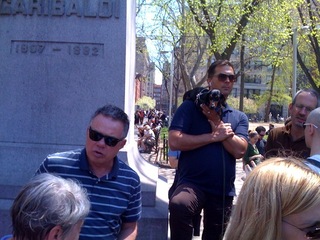
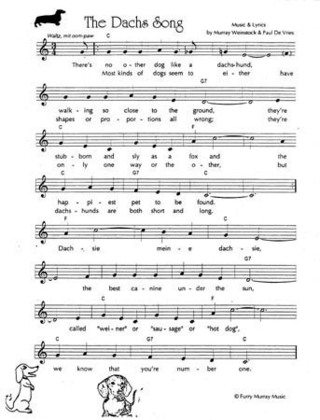

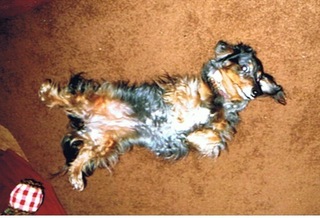
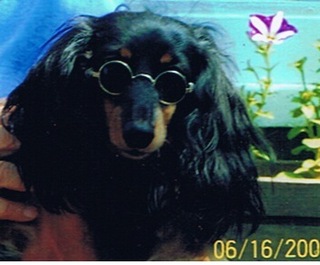
DID YOU KNOW?
-Queen Victoria’s husband, the German Prince Albert, brought Dachshunds to England in 1839, and presented one to his new wife, a dog that she named Dash.
One of the queen’s dachshunds buried at Windsor Castle has a six foot monument atop his grave. The inscription reads:
Here is buried Deckel
Deckel
The faithful German Dachshund of Queen Victoria
Who brought him from Coburg in 1845
Died August 10, 1859
Aged 15 years.
-Gergweis, Germany is known as the Dachshund capital of the world. Tourists can rent dachshunds by the hour for walks.
-The Dachshund is the only recognized AKC breed that can and does hunt above and below the ground.
-Dachshunds are eligible to enter more AKC performance events than almost any other breed. This includes agility tests, earth dog tests, field trials, obedience trials, and tracking tests.
-Standard dachshunds weight sixteen to thirty-two pounds. Miniatures are eleven pounds or less. A dachshund whose weight falls between eleven and sixteen pounds is affectionately known as a tweenie.
-A number of well-known people have had dachshunds. They include artists, John Everett Millais, Pablo Picasso, Andy Warhol and David Hockney; screen stars Clark Gable, Christian Slater and John Wayne. Newspaper magnate William Randolph Hearst placed a tiny ladder and slide in the swimming pool at San Simeon in case his favorite dachshund, Helen, fell into the pool.
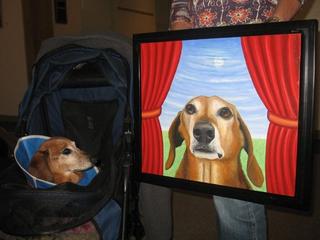
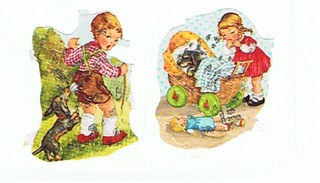


THE WINTER WOES OF WALDO
Patrick, Waldo and I were in Florida for part of the winter. The yard next door was a harbor for raccoons, one who tried to climb into one of our windows late at night. In addition the possum population is quite large-therefore we never let him out after dark unless on a leash.
One of Waldo’s favorite sports (besides killing mice and rats) is to chase the little lizards that populate the Florida landscape by the millions. He would chase them for hours, occasionally catching one, and sadly, toying with his captured prey. The lizards mostly stayed in the creases and folds of a plant that grew throughout the garden, A very attractive plant, purple and green, requiring little water. As Waldo pursued the lizards he would crush the leaves of the plant. Unknown to us the sap of the plant was an irritant and caused Waldo to have large welts on his belly. The cause was a bacterial and yeast infection.
After some anti-biotics and other medications it took about a month for the infection to clear up. Shortly after the infection cleared up Waldo began vomiting. After three days of vomiting he was x-rayed and the x-ray showed a large circular shape near his pyloric valve. The staff at the veterinarians office concluded that he must have some sort of obstruction. So we agreed to an operation. The operation revealed no obstruction but a large swollen dark mass near the pyloric valve. The vet performed a biopsy and the results did not indicate anything problematic.
So Waldo now has a little scar from incision but has healed very nicely. Out vet here in New York gave him a clean bill of health. Of course we were relieved and also grateful that we had purchased Veterinary Pet Insurance. The insurance company covered about two-third of the expenses.
Today Waldo is as much of a scamp as ever.
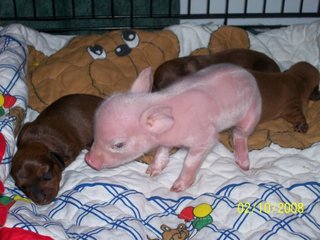
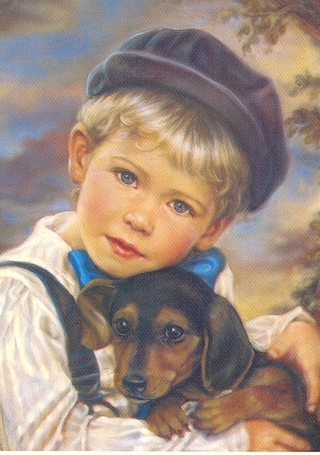
WHY DOGS MAKE US HAPPY By David Niven, PhD.
Life with a dog provides countless joys, numerous responsibilities, and of course, a few challenges. There is perhaps no better tribute to all that dogs do for us, however, than this simple fact: people who care for a dog live longer, healthier lives than most who do not.
There is nothing more debilitating than feeling that we don’t matter, that we lack connection to others, that our presence is unnecessary. A dog disputes that notion every day. We are constantly reminded that we are needed not only when we take care of our dog’s basic needs but also when they show us how much they enjoy us.
People meeting someone for the first time were thirty-nine percent more likely to rate that person as friendly if they had a dog with them.
ALLIGATOR SNACK?
We lovingly waited for beautiful Ava & handsome Humphrey to have their litter. Finally the day came and we got a call to confirm that YES! there was a black & tan dapple girl among the pups, so a few weeks later, I headed from Connecticut to Florida to see the new arrival. She was lovely! I went back home to CT until she was old enough to leave her Mother. Weeks later, we made the trip to Florida, picking up Chloe the luvdox in Port Orange, Florida then going to Venice Florida for spring break week.
The first night Chloe woke me in the middle of the night to go out. All went smoothly and we tucked back in for the night. "What a good dog" I thought. She had stayed with her mother a total of 12 weeks, and the breeder, Jane Chalfant had even taught her to come to our chosen name "Chloe."
The second night she also woke me. We went out, but this time the sprinklers were on. Chloe was feverishly skitting all over the place, running really fast, whimpering. After about five minutes of this, I decided she must be scared of the sprinklers, so I gave up and called her to me to come in. She quickly came right to me!
She sure was behaving strangely. I thought maybe a fire ant bit her or something like that.
As I turned to scoop her up, and click the lanai door shut, not more than a few feet from where we were standing, there was the BIGGEST alligator with his mouth wide open. He was right up to the door! I could barely scream - Clutching Chloe, I ran to wake the family- they weren't going to believe this one! And they couldn't. When they saw the alligator, they didn't know who he wanted to eat - me or Chloe the dappled snack. He wasn't leaving either!
My Mom called the alligator control, who finally caught him and moved him to another pond. It turns out that the alligator was about eight feet long!
Being from Connecticut, it never even occurred to me to look outside before I went out, even if it was the middle of the night. How such a BIG creature could get that close to us without me hearing or seeing anything is beyond me! Chloe sure has better intuition than I do!
Chloe the almost alligator snack is happy and healthy today- in Connecticut, where it is safer!
We love the newsletter, Kelly Bradley. Wethersfield, Connecticut

POEM
There was once a dachshund so long
It hadn’t any notion
How long it took to notify
Its tail of its emotion.
And so it was that while his eyes
Were filled with woe and sadness
His little tail went on and on
Because of previous gladness
TRAVEL SAFETY
All dog experts advise that a dog should never be left alone in a car. It takes only a few minutes for the heat to become unbearable in the summer, and to drop to freezing in the winter.
A dog traveling in a car or truck should be well-behaved. An undisciplined dog can be deadly in a moving vehicle. The dog should be trained to lie on the back seat of the vehicle, clipped to the safety belt. If the dog is in the front seat and an airbag opens it could severely injures or kill the dog.
Allowing your dog to stick its head out of the window is unwise. The dog may become distracted and jump or it may get something in its eye. Some manufacturers sell car seats and seat belts designed for dogs. Car safety is a serious matter. When a dog is traveling by auto, specially designed seat beats or the dog’s crate are the safest route.
In case of an accident it is often difficult for you to assess the dog’s injuries. The dog may appear normal, but there might be internal hemorrhaging. A vital organ could be damaged or a rib could be broken. Keep the dog as quiet and as warm as possible; cover the dog with blankets or your coat to let to let his own body heat build up. Signs of shock are a rapid or weak pulse, glassy-eyed appearance, or a subnormal temperature.
VETERINARY PET INSURANCE: During the lifetime of our previous dachsie, Damon, we spent well over eight thousand dollars for medical care over a fifteen year period. He had back surgery at age six and the last two years of his life were filled with medical complications. So when Waldo entered our lives we decided to get pet insurance. So far, we are quite satisfied with Veterinary Pet Insurance. We took the most expensive policy which comes to around Three hundred and eighty dollars per year. So far we have been reimbursed over two-hundred dollars. When a dog is young, medical bills are at a minimum, but as a dog ages the need for insurance to cover catastrophic costs becomes apparent. Getting insurance is expensive but I have figured that over a twenty year period at this rate, or slightly higher, we will have spent less on insurance than we did on Damon’s medical bills. I recommend this company because my vet recommended it and our experience has been positive so far. You may want to research various companies, ask for your vet’s advice, and solicit friend’s opinions about pet insurance policies. Pet insurance is something to definitely consider.
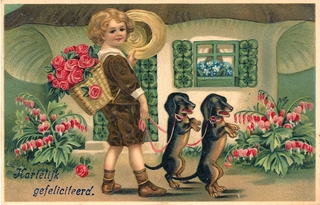
CANINE FRIEND LEADS TO MISSING DOG’S SAFE RECOVERY.
Frank and Frieda may stand barely a foot off of the ground, but don’t be fooled. They have the hearts of lions.
Frank and Frieda are dachshunds that belong to Mindy Hallene of Moline. They especially enjoy exploring their wooded yard and chasing animals through the underbrush.
Ms. Hallene said the dogs have been known to chase groundhogs, opossums, and even large raccoons in the past. She attributes their fearlessness to the fact that dachshunds were first bred in Germany to fight badgers.
“These dogs are really tough” she said. She recently found out just how tough they are. After playing outside one late June afternoon, Frank did not return to the house. Ms. Hallene and her sons, Jimmy, Bryan, and Alex were searching till four in the morning, but Frank was nowhere to be found.
The family then enlisted the help of neighbors and put reward posters all over Moline. But for six days they heard nothing. “We were just wrecks the whole week, thinking he was dead” said Ms. Hallene.
Frieda was no exception. She was inconsolable. She escaped the house at every opportunity, and kept running into the ravine behind the house and barking. The little dog came back with her paws and chest raw from digging, and had to be taken to the vet to have her paws lanced.
Then, as the family was leaving for a weekend trip to Wisconsin, Frieda jumped out of the car, ran down the ravine, and dove into a hole. Ms. Hallene heard one bark and a little whimper and thought “Oh my gosh, there are two dogs in there.” Frieda had been trying all along to rescue Frank, who was trapped in what appeared to be a raccoon hole that had collapsed, leaving him stuck between two boards.
The family called Falcon’s Nest Chimney Sweeps for help in freeing Frank. A few days before, owner Earl Bunch, had checked a hole close to the house for the dog, using special cameras he uses to examine chimneys. Mr. Bunch said he often gets called to rescue wild animals from chimneys and pets from trees, but this was the first dog he ever rescued. He and Ms. Hallene’s sons cleared away the brush and debris until Frank was freed. Despite being trapped for more than a week Frank did not look any worse for the wear.
Dr. Tom Grainer, a veterinarian at Oak Knoll Animal Hospital in Moline examined the dog and said the only thing wrong was a spot on his stomach that had been rubbed raw where he had been pinned beneath the boards. “He looked great for having been trapped a week,” Dr. Grainer said. “Lost dogs usually come through much worse.”
Ms. Hallene said that “Frank has been staying close to the house ever since.”

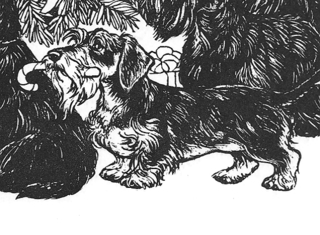
THE DACHSUND DURING WORLD WAR II
Dear Adrian:
The Dachshund Octoberfest was wonderful. Calvin, Haus, my husband, my son, and I stayed in the park for three hours talking and enjoying the beautiful dogs and their families. Thank you and everyone connected to the newsletter for all of the hard work you do.
I am enclosing a letter to the editor from LIFE magazine, September 25th, 1939 just as World War II started in Europe.
Best wishes, Valerie Erlandsen, Glen Cove, New York
Sirs:
My dachshund was loudly called a ‘Hitler dog” on the street today. This frightened my little dog, and I hasten to urge LIFE to join the widespread movement in England and the United States to protect these small and crooked-leg hounds from the indignities inflicted on them from 1914 well into the 1920’s
You will remember that dachshunds in the U.S. in the last war, along with sauerkraut and Wagnerian music, suffered complete social ostracism. They practically disappeared from shows, and the breed itself went down drastically in number and quality. To protect the few that remained, the American Kennel Club was forced to change their name to “badger dog.” Chief offenders were the cartoonists who made the dachshund, most inappropriately, a symbol for the Nation’s Wartime animosity against the Germans.
Let cartoonists of this generation learn that the dachshund today is as thoroughly American as any other breed. Since 1930 they have climbed from twenty-seventh to seventh place in kennel Club registrations. Of the 3,213 Dackels registered last year, all but 93 were American born.
For the international background of the dachshund I refer you to Herbert Sanborn’s excellent book The Dachshund, or Teackel ( Orange Judd, 1937). For the fact that dachshunds are the most popular show dogs in America I refer you to LIFE, June 14, 1937. For an impression of an individual dachshund, American-born, I present you with my wife’s pictures of our dog, Cissy.
R.A. Childress, Philadelphia, Pennsylvania”
Life magazine then proceeds to picture well-know people and their dachshunds. Amongst them were Joan Crawford and her three dachshunds by her pool, Lord and lady Halifax, Sir Neville Henderson, and the John Roosevelts of Brookline, Massachusetts.
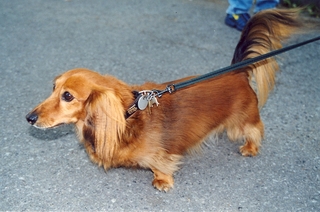
EVERYTHING YOU EVER WANTED TO KNOW ABOUT DACHSHUNDS
QUESTIONS AND ANSWERS BY HELEN BASSETT
(Helen Bassett wrote for the newsletter for over twelve years. We get so many requests for reprints of Helen’s column that we will do a reprint once a year.)
Dear Helen Bassett:
Our Foxy, a black and tan smooth standard, is a romantic at heart. He loves to take long walks on the beach. However, he has a really disgusting habit that would seem to spoil his chances of finding a like-minded soul mate. He is addicted to rolling around, with an absolutely ecstatic expression on his face, in anything that he finds that is the least bit foul smelling, dead fish, dead sea gulls, feces, things like that. We have despaired of re-educating him. But what we want to know is, why does he do that?
Sincerely, Mrs. Dagmar Hoffman, Bellport, Long Island
Dear Mrs. Hoffman:
This is a question that many people have asked and all sorts of experts, scientists, behaviorists, and veterinarians, have attempted to answer. All agree that it is most certainly characteristic canine behavior. The bottom line, however, is that no one is precisely sure why it is. Some say it hearkens back to a more primitive instinct to cover one's own scent while on the prowl. Others say it may be considered to impart an upgrade to one's prowress as a mighty hunter in the right circles. Some even venture that 'eau de carcass' is very high on the list of famous canine perfumes (and it is a very good thing that grooming parlors do not subscribe to that theory!). What it amounts to is that it is definitely a "dog" thing, and those of us not of the species could never understand.
Because we live so familiarly with our pets, we tend to forget that they are programmed very differently from us, and although they are masters of adaptation, they are still keeping to a very different set of rules besides the ones we impart to them.
Dear Helen Bassett:
We have three adorable mini dachshunds, Wotan, Siegfried, and Brunhilde. Wotan is unflappable, but Siegfried and Brunhilde are really frightenend by certain kinds of noises. Siggy is terrified of thunder, but not fireworks, and Brunny is afraid of fireworks, but thunder doesn't seem to upset her at all. When the noises start, their expressions glaze over and they shiver violently or sometimes have accidents on the floor. Fortunately for us, they don't get upset at the same time. Obviously, Brunhilde's episodes are fewer and further apart than Siegfried's. We can't seem to soothe either one of them, though. We feel so helpless. Is there anything we can do to convince them that they are all right?
Sincerely, Mrs. Blanche Nero Stillwell, New Orleans, Louisiana
Dear Mrs. Stillwell:
Selective noise sensitivities are quite common. The reactions can range from mild apprehension to sheer terror. There are techniques used by trainers and behaviorists for desensitizing afflicted dogs. With time, and a lot of patience, the stress can be minimized for many dogs, but there is always and individual who will be resistant to the treatment. For the sake of argument, let's say you took Siegfried and Brunhilde to a qualified behaviorists for several sessions and, just your luck, neither one responded satisfactorily. There are two ways you can go on with this. If they are among those severely upset, you might want to talk to your veterinarian about having a mild tranquilizer on hand, if that will alleviate the problem. In general, you can also try to use your own body language to import a sense of safety during the duration of the episode by holding them, stroking them calmly, and, if they respond to your efforts, praising them extravagantly for their bravery.
Dear Ms. Bassett:
My lovely long hair dachshunds, Trilby and Svengali, love to ride in the car. They behave beautifully during the whole trip, be it long or short. They sit quietly on the passenger side seat, next to me as I drive, looking out the window (closed) and enjoying the ride. Now I am wondering if this is such a good idea after what I have been reading about passenger side airbags injuring or even killing small children. What do you suggest?
Thanks for your always helpful column, Matricia Gracie, Los Angeles, California
Dear Ms. Gracie:
Although automobile companies probably do not keep statistics for injuries to pets, the ones they have on injuries to children are grim. An air bag deploys at speeds between 140-200 miles per hour. A dachshund size dog in the passenger side seat would probably seem to be at grave risk should one deploy.
The safest way to travel with a dog in a motor vehicle is to have the dog secured in a portable crate in the back seat of the car or the cargo area of a wagon or van. If this is not practical for you, I would definitely introduce Tribly and Svengali to the joys of back seat driving!
You emphasized your closed windows. In terms of car safety, it also goes without saying that no matter how popular the image of dogs ecstatically hanging their heads out of car windows to enjoy the ride, it is irresponsible to permit one to do so. Not only is there danger of the dogs jumping or falling out of the speeding vehicle to be killed or horribly maimed, but dangerous objects, dislodged by tires or hurled through the air, too often fly up to injure the dog. Many dogs have been blinded by high speed stones, pebbles, or glass fragments, striking their eyes.
Finally, of course you know this, but it bears endless repetition. No dog should ever be left alone in a car, at any temperature, even with a window cracked open, for any length of time, ever.
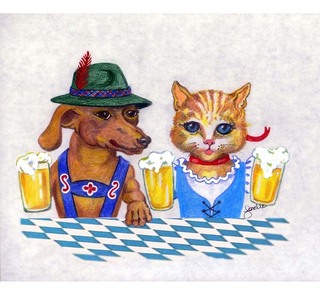
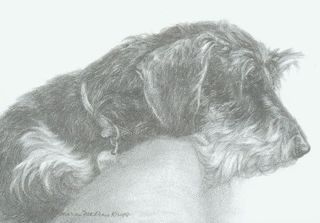
TOBACCO EATING DACHSHUND
Wolfgang Treitler, from Graz, Austria, says his twenty-two year-old Dachshund, General Edi, has been munching his way through ten cigarettes a day for years.
Mr.Treitler said: "His old owner abandoned him and so we took him in seventeen years ago, and noticed straight away that he was in the habit of eating cigarettes.
"He eats the tobacco and the paper, and then chews a while on the filter before spitting it out of his mouth. "On average he eats about ten cigarettes a day, but all of his teeth are fine and he is as fit as a puppy, even though he turned twenty-two this week."
Local veterinarian Harold Mayr said: "Nicotine normally leads to poisoning in dogs, but in this case the animal has obviously become addicted to it which has increased its level of tolerance."
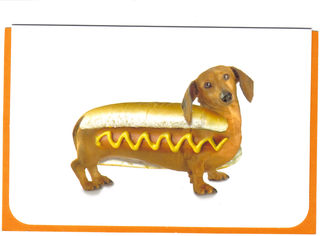
CASH HOG:HEFTY DACHSHUND HAS A TASTE FOR MONEY.
DFC member, Patsy Miller, of Winston-Salem, North Carolina sent this clipping from a local paper:
Dear Dr. Fox: I have two female dachshunds, ages two and three. The two year old, Emma, is very overweight. Both receive the same amount of weight control food each day, and they spend much of the day chasing squirrels in the back yard. Emma is still seven pounds above her suggested weight limit.
Also, she eats money. I know it is not unusual for a dog to shred tissue paper or newspaper, but she gets money out of my purse (and money from other family members) and eats it. I have found pieces of money all over the house. I have found portions of One dollar and five dollar bills buried in the back yard. There are some forms of paper that she never touches, but certain pieces of mail and any kind of paper money seem to be her weakness. After losing almost fifty dollars to her addiction, the family has learned to keep their wallets out of her reach.
What could be causing her weight problem? S.B., Fort Worth, Texas
Dear S.B.
It is my understanding that in the printing of paper money (at least in the United States) the sizing/finish that is put on the money contains and extract of animal fat or tallow called stearate. Stearates are also on certain plastics, processed films, and many cosmetics, which may explain why animals like to lick such materials. So your dog is probably reacting to the animal-fat extract, which should not cause any health problems—unless she were to eat an entire wallet.
A PRAYER ANSWERED
Lying in her hospital bed, tears streamed down Stacy Stewart’s cheeks as Shelby, her miniature dachshund, drenched Stewart’s face in kisses.
“It’s okay, It’s okay,” Stewart whispered repeatedly in the dog’s floppy ears.
The emotional reunion came nearly a week after a car wreck left Stewart in St. Francis medical Center in Cape Girardeau, Missouri. She had a broken left shoulder, a fractured right arm, and four cracked ribs. And the wreck left Shelby alone, foraging in the southeastern Missouri countryside.
On the night of October 22nd, 2004, Stewart lost control of her jeep, and the vehicle overturned on Interstate 55 north of Fruitland, Missouri. Stewart’s other dog was killed. Shelby was missing.
Friends were hesitant to tell Stewart that there was a chance that the dog could still be alive. ‘They did not want to get her hopes up,” said Stewart’s friend and co-worker, Mark Parsons, his pants spotted with mud and water stains from helping to search for Shelby.
Since news of the missing dog was reported, southeast Missouri residents had been phoning in Shelby sightings while Stewart’s friends and family searched. On Tuesday night, Linda Kesterson called to report that she had seen a dog like Shelby several times outside her home in Fruitland.
At nine am. Thursday, parsons and co-worker Laura Karr drove from St, Louis, met up with Stewart’s sister, Sandy Stewart and took to the woods around the Kesterson’s house. Just after noon the search party gave up hope and returned to Kesterson’s house to thank her for her help. As they pulled out of the driveway, Sandy Stewart turned left. There was Shelby.
“She was just standing there like a prayer answered,” Parsons said.
But when Sandy Stewart called Shelby’s name she darted off into the woods. It took another two hours before a trail of bacon and bologna led the timid refugee into Kesterson’s garage, where she was finally corralled.
From her hospital bed, Stacy Stewart struggled to describe her emotions. “I don’t have the words,” she said. “It’s been a rough week. Almost unreal.” She looked at Shelby and said ‘I think she is glad to be home.”
LOVE FROM ABOVE
Jillian McVickar, 15, of Boston, Massachusetts, wrote the following poem to celebrate her love for Oscar, her miniature dachshund.
One gaze from his pleading soft brown eyes, and I knew compassion.
One touch of his silken, dappled coat and I felt comfort.
One sound of his courageous bark, and I was protected.
One kiss from his sandpaper tongue and I knew friendship.
One wag of his loving, gentle tail and I saw happiness.
One moment of his unconditional love and I felt God’s grace.
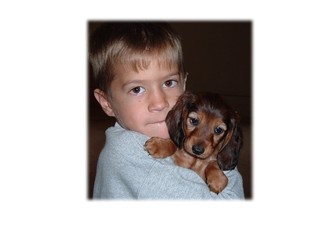
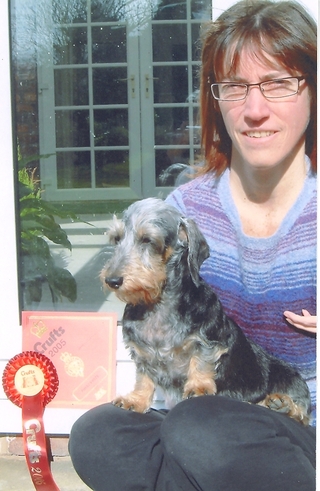
always happy when we have visitors from another country. Helen, shown here with Poppy, raises wire hair dachsies and has
shown her dogs at Crofts.
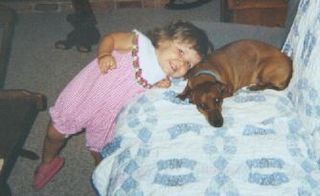
I GIVE THANKS FOR ANIMAL FRIENDS
Sharing my life with a pet is a decision I do not make hastily. Before bringing an animal into my home, I consider all of the responsibilities that come with it. This is one of God's creatures, and I want to give it the time and attention it deserves.
God has created a tremendous variety of animals, and each one has its own traits and disposition. In considering a new pet, I ask myself if my home and yard provide a safe environment for this animal. Will this pet fit in as a member of the family? I ask God to guide me in making my decision.
I will be sharing my home and my heart with this pet. Gazing into its eyes, I see life and love sparkling there. I recognize my pet as a friend and companion that is ready, willing and able to share its love and affection with me. What a gift my pet is!
"So God created…every living creature…And God saw that it was good."-Genesis 1:21
Sonia Johnson of Topeka, Kansas submitted the following excerpt from The Daily Word, a monthly journal of Unity
DACHSHuND QUOTES
When rejected by his father he became industrious and motivated; when rejected by his mother he became proudly independent; when rejected by his siblings he became deeply compassionate; but when rejected by the family dachshund he became a complete nut case.
-from a case history of Sigmund Freud
The secret of architectural excellence is to translate the proportions of a dachshund into bricks, mortar and marble.
-Sir Christopher Wren
Man, I have been taught, was made in God's image but the dachshund, I have come to believe, was made in God's spirit.
-Solomon
David wants his dachshund back? Over my dead body!
-Goliath
Man who buys Pekinese requires great status. Man who buys dachshund acquires great status.
-Confucius
DACHSHUND PROVING TO BE 'PUURRFECT MOTHER'
Pebbles the dachshund is playing mom to a couple of kittens. The new mom is nursing two kittens along with her litter of four puppies born on Father's Day.
The stray kittens were brought to the Santini Coin Laundry on Wednesday by someone who knew about the puppies, said Butch Stillson,52, owner of pebbles and the laundry.
"Pebbles took them right in. She cleaned them up," stillson said. "They have that motherly instinct."
Pets are not like people who make distinctions based on skin color and other differences, said Stgillson, an equal opportunity pet owner.
Besides Pebbles and her litter, he has three other dachshunds, a beagle-lab mix, three rabbits and a cat. "I have a big back yard" he added.
Dogs nursing kittens are not unheard of, said veterinarian Wayne Mogavero of the Tails-A-Waggin Animal hospital in South Fort Meyers.
Dog milk is nourishing but it won't provide the antibodies the mother cat would have produced, he said.
Puppies, if they are small enough, also can be nursed by cats, Mogavero said. The mouths of puppies, however, often are too large to get a good grip on a cat's nipple.
Pebbles' kittens could learn some social behavior from the dogs, said veterinarian Suzanne Hurst of the Kindness Animal Hospital in Cape Coral. The kittens and the puppies will learn how hard to bite and other behaviors together.
"They may be a little more rough and tumble. Fortunately, the instinct to use a litter box is ingrained in cats," Hurst said.
Her own dog lived with cats when he was young and impressionable. "He even does something akin to a purr." She said.
INCIDENTAL INTELLIGENCE
In the July 9, 2001 issue of People magazine acclaimed photographer David Douglas Duncan recalled how Picasso once cut a rabbit shape out of a cookie box for Duncan's dachshund, Lump. He says 'Lump tore it apart and ate the pieces, because there were still crumbs left. I'm going to do a book called The Dog Who Ate Picasso." A few months later, Lump, on a visit to Picasso's studio, decided he wanted to stay and refused to leave with Mr. Duncan. As a result, Picasso, became the proud companion of a dachshund.
Although it is the smallest of hounds, many think of the dachshund as the biggest in spirit. Best known for its distinctive build, it is also a dog of character, intelligence, hunting spirit and absolute, unrelenting devotion. Developed in Germany, where it was called "Badger Dog," or dachs-hund, this low-slung breed appears in illustrations dating to the fifteenth century, although a proper breeding program probably did not begin did not begin until the seventeenth century.
-AKC Gazette, February, 2001
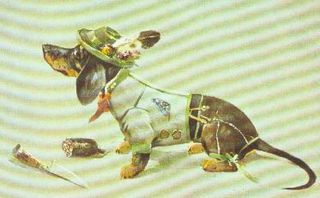
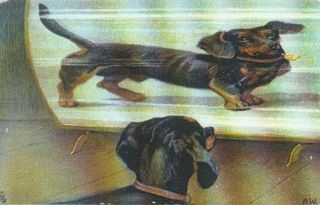
Dachshund Quotes
"Man who buys Pekinese requires great status, man who buys a dachshund acquires great status." -Confucius
"Nothing will turn a man's home into a castle more quickly and effectively than a dachshund."
-Queen Victoria
"You say my nose, sir, reminds you of a dachshund? That is the first flattering remark anyone has made of it."
-Cyrano de Bergerac
"Wake me up as soon as you have the dachshund housetrained."
-Rip Van Winkle
BOOK REVIEW
DACHSHUNDS FOR DUMMIES
By Eve Adamson
Published by IDG Books, 2001
I, for one, can never own too many books about dachshunds. In the last issue we wrote about Ann Gordon's book "The Dachshund-A Dog for Town and Country. Now, along comes another "must have" book for the dachshund lover. The author, Eve Adamson, has been a dachshund fan since childhood and a regular writer for Dog Fancy magazine, specializing in breed profiles. Her love of the breed is in evident in this thorough guide to the dachshund.
Ms. Adamson begins her book with a discussion of pet ownership. She then writes of the characteristics of a dachshund, once called "The Royal Teutonic Dog", including the pros and cons.
One paragraph that particularly caught my attention was "Dachshunds live to eat, and obesity puts a further strain on a dachshund's back--not to mention his heart and entire body. Cute and pleading as the dachshund may be, you must be prepared to keep your dog's eating under control." Anyone who has lived with a dachshund will nod their head in agreement. This was a good reminder that I can not allow the sorrowful gaze or the whining in front of the refrigerator to influence me to give my dog that extra treat.
She also stresses that you must be prepared to accept our role as pack leader or your dachshund will get the idea that you live to serve him. Unfortunately, at our house, this notion has taken root and we are often bossed around by a fourteen year old thirteen pound dictator. Occasionally a member of the pack will revolt but a struggle usually ensues.
One chapter that was especially helpful to me is entitled "Your Aging Dachshund." Ms. Adamson notes that the five most common diseases of aging in dogs are kidney disease, liver disease, diabetes, cancer, and heart disease--all diseases common to humans. The good news is, once your dog has passed her seventh year of life, your dachshunds chance of developing canine intervertebral disc disease decreases (although the classic onset years are between five and ten years of age). After eight years old it is suggested that you take your dog for a checkup once every six months. The vet will take blood, urine and heart tests and do a physical examination. Also, don't be surprised if your dachshund starts to sprout gray hair around his seventh or eighth year. It's perfectly normal and is no indication of poor health.
This book contains sections on diet, exercise, training and a host of other topics that cover the entire range of sharing your life with a dachshund. The book ends with a section listing web sites and a bibliography. The care and detail that Ms. Adamson has put into this dachshund manual
should serve any dachshund owner's needs.
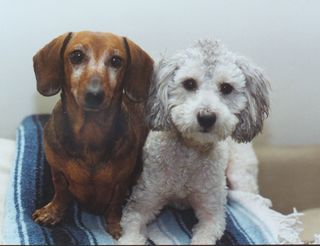
Dear Adrian (photo of Samm and Ralph)
Greetings to you, Patrick, and Waldo. It was great seeing all of the dachshunds and their owners at the 2004 Dachshund Octoberfest in Washington Square. I had a great time!
Being at at this dachsie fest was bittersweet. In February my ten-year old dachshund, Samm, died. Samm was with me since he was eight weeks old and he enjoyed his share of dachsie fests. He mixed and mingled with the dachshund owners, though he tended to be sometimes ‘shady’ with the doggies. The photo above shows Samm and his brother, Ralph (a poodle/terrier mix). It always tickled me to watch them interact, especially during playtime, when Samm flexed his alpha dog muscles.
I would like to say thank you to you and your editorial staff for all of the energy that goes into creating the informative and fun loving newsletter for all of us dachshund owners. As much as I look forward to the April dachshund fest, I’m more so looking forward to the day when I will be bringing another dachshund at home.
Peace and Blessings, Tracy Wells, Engglewood, New Jersey
DACHSHUNDS FOREVER VIDEO!!!
“Dachshunds Forever” is a wild, wacky, wonderful look into the world of our favorite companions and the humans who love them.” Adrian Milton.
“Dachshunds Forever”, an entertaining twenty-seven minute video by television documentary producers Rob Kuhns and Esther Cassidy is a must-have for dachsie lovers. It was filmed in Washington Square Park when three hundred dachshunds and their human companions converged for the 2000 Dachshund Friendship Club OctoberFest. What could be more enjoyable than so many short-legged sausage-shaped canines and their devoted human friends in one place? “Dachshunds Forever” is a joyous collection of stories of love, adventure, dedication, loyalty, courage, and valuable information about the distinctive pedigree we love so well. Rob Kuhns and Esther Cassidy’s work has appeared on PBS, ABC, TBS, Discovery, National Geographic, Court TV, the Sundance Film Festival and over a dozen film festivals around the world. To order “Dachshunds Forever” send a check or money order for $25 (payable to Esther Cassidy) to Esther Cassidy, 32 Union Square East, #816, New York, NY 10003. For more info e-mail robkuhns@aol.com.

From the moment you open the first page of the enchanting book “Peter Sausage” to the last page, one is touched by the warmth and love that pervade this story of a rescued dachshund. DFC member, Vicki Cosgrove, has written a lovely book entitled “Peter Sausage.” This is the touching tale of a little dachsie, Peter Sausage, who was rescued by the Cosgrove family. Vicki’s sister, Cathy, has illustrated the book with the most charming drawings that capture the loving essence of our favorite breed, the dachshund. Peter was in pretty bad shape when he was found on the street by Cathy. He was frothing at the mouth and his feet were bleeding. She took him to a vet, where he was cleaned up, given all the proper shots, and a complete checkup.
Vicki and her sisters, Diana and Cathy have rescued many animals over the years. They read about a dachshund, Squeaky, in Newsday. Of course, they had to rescue him! Squeaky is blind, but he has adjusted quite well to the Cosgrove household. Three other dachshunds, Otto, Hummel, and Schubert were rescued from a pet store. Otto had grown so large that he barely fit into his cage. When the Cosgrove sisters came into the shop he became so excited that he stood on his head. The dogs sat in a cage there for several months because no one was interested in buying them. The Cosgrove’s did not want to support a pet store but they saw that these dogs needed to get out of that pet store and into a good home. So home they came.
In addition to dachshunds, Vicky, Diana, and Cathy have rescued other breeds. They have had a St. Bernard, a Labrador retriever, a German Shepherd/wolf mix. And last but not least there is Pierre, a beagle, who was found wandering in the neighborhood and was quite delighted to come home with Cathy.
At every Dachshund Octoberfest and Spring Fiesta, the Cosgrove sisters are in attendance and their dachsies are always dressed in the most festive fashions. Their devotion to animal welfare is a true inspiration to all animal lovers.
To order the book, “Peter Sausage” or “Squeaky Time” contact Xlibris at: www.xlibris.com/bookstore or you can order by telephone by calling 1-888-795-4274, ext. 276.
Type your paragraph or brief header here
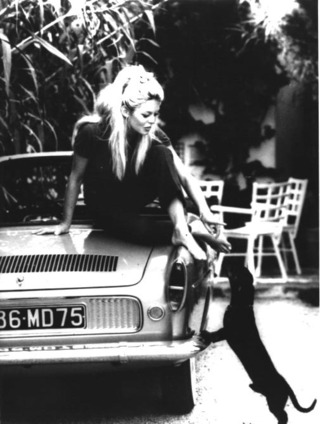
DODGER: Dachshund Orthopedic Disc Group Resource
In March of 2002, Dodgerslist was founded. The name DODGER came from a Dachshund in California who was euthanized prematurely because the vet and owners did
not know of alternative treatments available and how
well they are working. Dodgerlist's goal is to
educate Dachshund owners about disc disease. We
wanted to let them know there were many alternatives
to euthanasia. Most Dachshunds who do go down will
eventually return to some function, if not all. There
are many treatments now that are working very well.
Acupuncture and the drug Adequan seem to be really
helping. Hydra-therapy using a water treadmill is
doing wonders. All of these work well in conjunction
with surgery or in a conventional treatment plan.
Dodger has accomplished a lot since it was created. We have brochures now in vet offices and with owners in this country and in other countries. We have been in contact with researchers at the University of California at Davis and hope to have gene research started. We have sent questionnaires to specialists and veterinary schools around the country hoping to inform ourselves of treatments and latest research. We do advertising in dog magazines and club newsletters. We do whatever we can do to keep our loved pets from being euthanized without being given a chance.
Please visit our web page at http://www.dodgerslist.com
Come join us at yahoogroups, if you can, to help fight this disease.
Best wishes, Linda Stowe, Founder, Dodgerslist
Lstowe@staff.uiuc.edu

“There is honor in being a dog.” – Aristotle
“In the beginning God created man, but seeing him so feeble he gave him the dog.” - Alphonse Toussenel
“I think we are drawn to dogs because they are the uninhibited creatures we might be if were not certain we knew better.” – George Bird Evans
“The old simply need to touch the brow of a dog, to look into his eyes, to feel its lick, so that they may experience again the freshness and joy of life.” – Anonymous
‘Children retain the dog’s capacity for spontaneous joy until they unlearn it from their elders.” - Jeffrey Moussaieff Masson
“Acquiring a dog may be the only opportunity a human ever has to choose a relative.” –Mordecai Siegal
HEALTH TIPS for DOGS and HUMANS
Studies show that pet owners have less illness, recover from illness faster, and are likely to live longer. Interestingly, dog owners will walk with their dog regularly, yet will not walk by themselves. Consequently, dog owners get more exercise. Talking, touching, exercising, laughing, hanging out together with our pets all makes people healthier. It lowers blood pressure, speeds recovery from heart attacks, reduces stress and helps us to feel less isolated. In addition, having a pet in the household seems to improve the owner’s relationships with other people. Couples that have animals are more satisfied with their marriage and handle stress better than couples who are petless. Pet owners also get lots of practice sharing their feelings: Most pet owners say they have regular conversations with their pet. In addition, having an animal in the house connects us to other living creatures on this planet. In more ways than one pets take care of their owners, so here are some suggestions for taking care of them:
-Steer clear of pet foods that contain chemical preservatives.
-Make sure to spay or neuter your dog so that they may live longer and be free of certain types of cancer.
-Give your dog supplements in his or her dry food. A teaspoon of peanut oil or sunflower oil provides linoleic acid, which contributes to healthy skin and coat.
-Check out supplements that contain essential fatty acids and phytonutrients.
-Give your pet some healthy grass to chew on, such as sprouted barley grass or wheat grass.
-Be sure to give your pet a minimum of twenty minutes a day exercise.
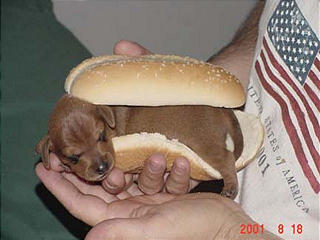
Coats of Many Colors
Often, at one our DFC festivals, someone will see a dog that sports an unfamiliar color and will ask “Is that a dachshund?” Dachshund coats appear in many colors and patterns. There are no color disqualifications in the official breed standard nor mention of unacceptable colors. In addition, the genetics of color inheritance in our breed combines several basic colors, with inherited “patterns”, all subject to ‘modifying genes,” making a vast array of colors genetically possible.
Here is a list of colors that are recognized by the Canadian Kennel Club: Black and tan, Chocolate and tan, Blue and tan, Isabella and tan, White and tan, Red, Sable, Wheaten, Brindle, Wild boar, Black and tan dapple, Chocolate dapple, Blue dapple, Red dapple, and Silver dapple. In addition, on occasion, rare variations on the above colors will occur.
